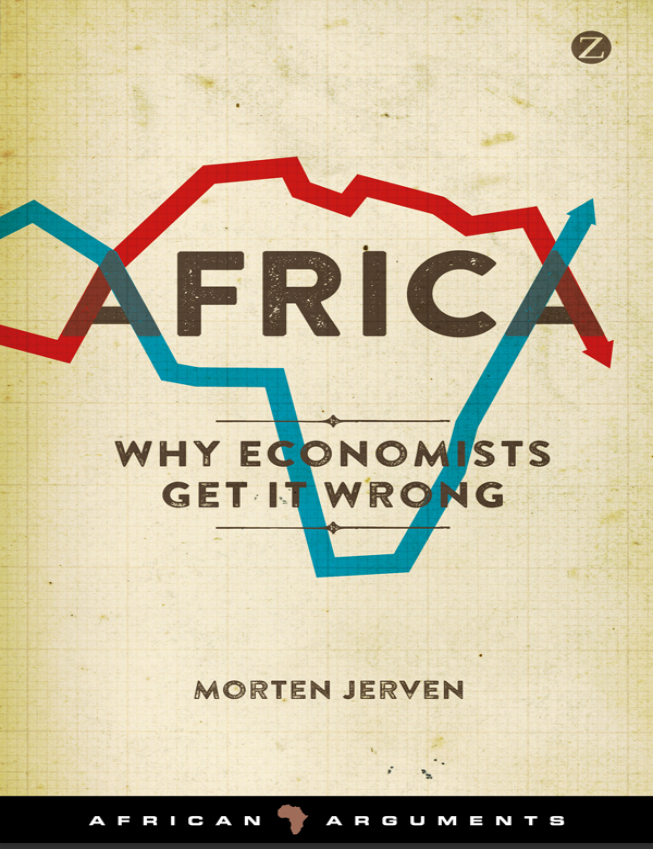AFRICA Why economists get it wrong by Morten Jerven

1 | Misunderstanding economic growth in Africa
For two decades, mainstream economists studying African economic
growth have been trying to explain a chronic failure of growth – something
that never occurred (Mkandawire and Soludo 1999). I will explain how that
could happen. I will also show how that attempt affects our ability to
understand economic growth in Africa today. The work of economists is
always evolving over time due to changes in methodology, theory and
technology (Morgan 2012). In the 1980s, some important innovations took
place that had significant implications for the scholarly work of economists.
The first step was a gradual tendency away from theorizing about economic
growth toward conducting empirical tests of growth theory.
1 As we will see,
it is one thing to think about what the factors that determine economic
growth might be, but it is quite another to use real-world data from all the
countries of the globe in order to test whether the theory of what drives
economic growth holds.
Theoretically, the basics of economic growth are straightforward and
self-explanatory. The factors that drive economic growth – called the
factors of production – are labor, land and capital. Together, these three
factors produce goods and services. Economic growth is therefore a result
of the increased use of the factors of production. Output increases when
more people, more capital or more land is used for production.
Although this is called economic growth, it is a particular kind of
economic growth known as extensive growth. In extensive growth, you
only get more for more: that is, the increases in economic growth are
proportional, or less than proportional, to increases in the use of resources.
Intensive growth is what happens when growth is more than the
proportional increases in the factors of production. Any growth that is not
attributable to the increased use of resources is often referred to as ‘total
factor productivity’ in the growth literature. The total factor productivity
increase can be a result of improving the quality of the inputs. And this is
often interpreted as technology – which has a broad definition and ranges
from things such as smart gadgets to general changes in how production is
organized to legal frameworks and structures in society at large (Jones
1988).
For an intuitive way of understanding why output may be increasing
more than would be proportional to the increase in inputs, I use the example
of moving a sofa. If you are one person trying to move your own sofa,
productivity is very low. It is hard to get a grip on the sofa. If you get help
from your friend (or you add one more unit of labor), total productivity
more than doubles. If you add another friend, there is no increase in
productivity; there may even be a decrease in output, as your second friend
might distract you, order pizza or otherwise get in your way when you are
trying to move the sofa. Productivity could also benefit from capital
investment technology (such as using a strap, putting the sofa on a trolley,
or using a forklift or a van). Such increases in output would require both
capital and technology, and they would only be justified if you were in the
business of moving many sofas regularly. Thus, there is more than one way
of increasing output – some comes through adding more input/s and some
through improved methods and technology – and the relationship between
outputs and inputs is not linear, nor is it always rational to maximize output.
The bottom line is that economic growth goes far beyond mere
increments of labor and capital. The sources and determinants of economic
growth are not limited to basic processes of accumulation. How production
is organized matters, and this extends to the very fabric of society – the
rules that govern human behavior, or what economists have become
accustomed to referring to as ‘institutions’ (see Bardhan 2005). We can
understand this, but to go ahead and use data on labor, capital and GDP
growth and then empirically measure it is quite another matter.
Initially, economists were quite happy to leave total factor productivity as
an unexplained residual. In a framework called ‘growth accounting’, you
enter increments in capital or labor as explanatory or independent variables
in a system of equations that explain changes in economic growth. By doing
this, you can, with a few assumptions, calculate how much of the economic




